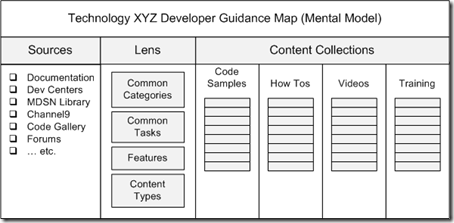Developer Guidance Maps Roundup for ADO.NET, ASP.NET, Silverlight, Windows Azure and Windows Phone
Developer Guidance Maps are treasure maps and guided tours of our developer content collections. They are consolidated and organized views of content collections spanning Channel9, MSDN Developer Centers, MSDN Library, Code Gallery, CodePlex, the All-in-One Code Framework, www.ASP.net, www.Silverlight.net, WindowsClient.net, etc. I’m creating these as part of our “IA” effort. One of the things I’ve been tasked with is creating an IA, or "information architecture," for the developer guidance ecosystem at Microsoft. As part of that effort, I have to map out what we already have as well as identify the various sources of content and clearing houses. Rather than simply do this behind the scenes, I’ve decided to share the maps with you as I go so that you benefit … thus Developer Guidance Maps were born.
Each map basically provides a map of the technology (common categories, features, scenarios), sources of where to look for key content, a Getting Started section of content, an Architecture and Design section of content, and then extensive content collections for Code Samples, How Tos, Videos, and Training, organized by scenarios and common tasks.
Benefits of Developer Guidance Maps
- Show you the key sources of developer content and where to look (“teach you how to fish”)
- Provide an index of the main content collections (Code Samples, How Tos, Videos, and Training)
- Use the map as a model for creating your own map of developer guidance to streamline your learning and ramp up.
Developer Guidance Maps Available for Download
Here is a roundup of the current Developer Guidance Maps:
- ADO.NET Developer Guidance Map
- ASP.NET Developer Guidance Map
- Silverlight Developer Guidance Map
- Windows Azure Developer Guidance Map
- Windows Phone Developer Guidance Map
Mental Model for the Maps
Here is a simple mental model for the Developer Guidance Maps:
The Approach
Rather than boil the ocean, I’ve used a systematic and repeatable approach. I’ve focused on common categories and features for key technologies and simple content types. Here is how we prioritized our focus:
- Content Collections: Code, How Tos, Videos, Training
- Building Apps: Cloud, Data, Desktop, Phone, Service, Web
- Technology Building Blocks: ADO.NET, ASP.NET, Silverlight, WCF, WPF, Windows Azure, Windows Client, Windows Phone
The Maps are Works in Progress
Keep in mind these maps are works in progress and they help us pressure test our simple information architecture (“Simple IA”) for developer guidance at Microsoft. Creating the maps also helps me test the model, create a catalog of developer guidance, and easily find the gaps and opportunities. While the maps are incomplete, they may help you find content and sources of content that you didn’t even know existed. For example, the All-In-One Code Framework has more than 450 code examples that cover 24 Microsoft development technologies such as Windows Azure, Windows 7, Silverlight, etc. … and the collection grows by six samples per week.
Here’s another powerful usage scenario. Use the maps as a template to create your own map for a particular technology. By creating a map or catalog of content for a specific technology, and organizing it by topic, feature, and content type, you can dramatically speed up your ability to map out a space and leverage existing knowledge. (… and you can share your maps with a friend ;)
My Related Posts
